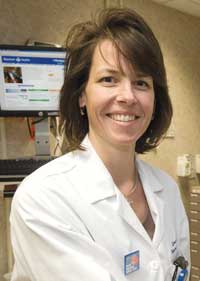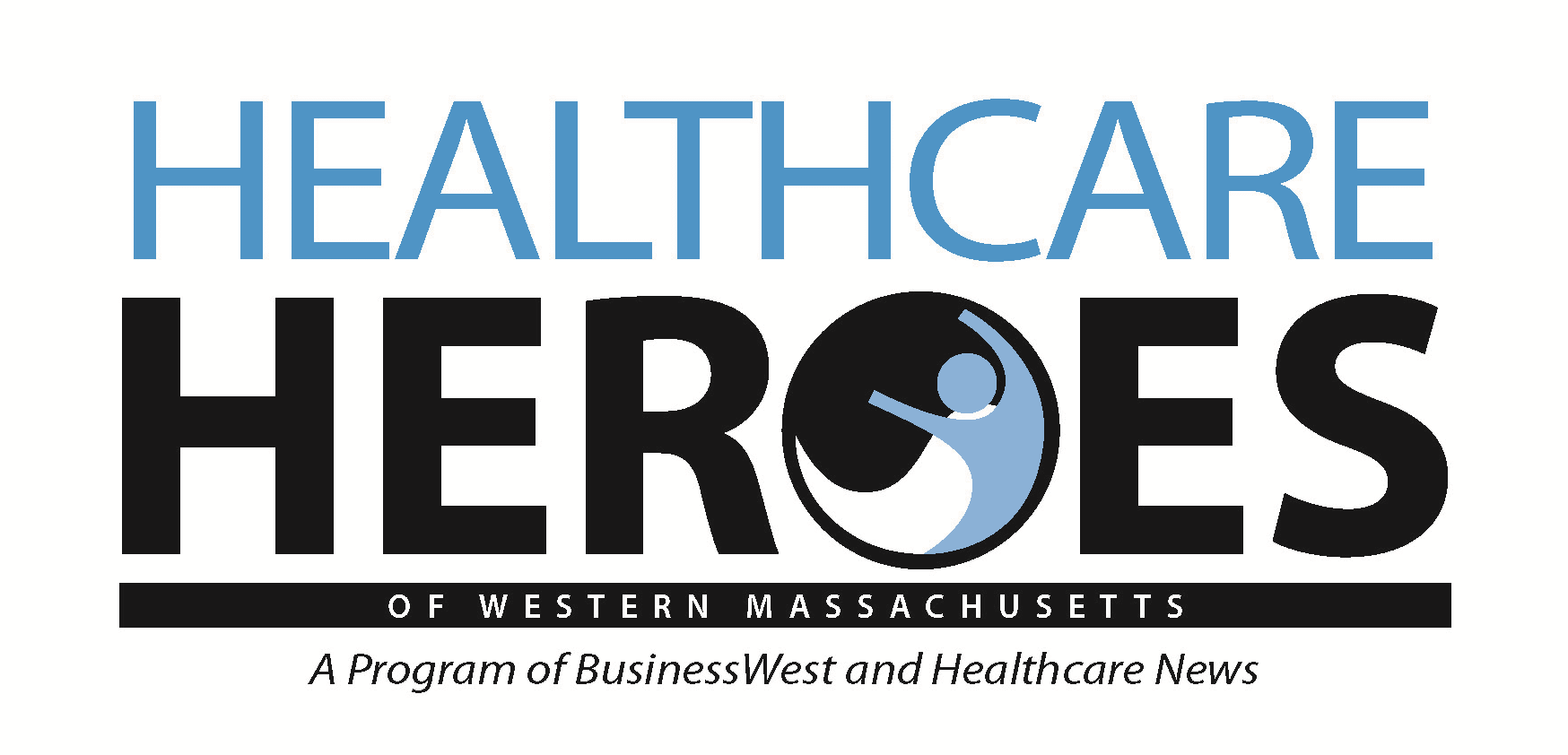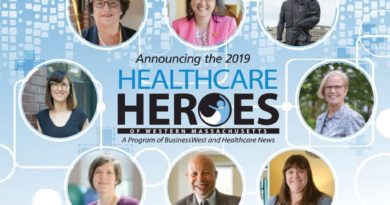Viral Threat U.S. – Healthcare Workers Grapple with Arrival of Ebola
By now, most everyone knows the story.
A man named Thomas Duncan contracted the Ebola virus in West Africa, then flew to Dallas, where he developed the symptoms of a hemorrhagic fever four days after arrival. He was treated at Texas Presbyterian Hospital, which isolated the patient and sent specimens for testing to the Centers for Disease Control and a Texas laboratory.
Unfortunately, Duncan died of Ebola on Oct. 8, but not before two nurses, Amber Vinson and Nina Pham, also became infected. They were isolated, aggressively treated, and survived. Meanwhile, Duncan’s family and known contacts were located and monitored for 21 days after suspected exposure. None of them ever contracted the virus.
Dr. Sarah Haessler takes three lessons from this story: Ebola is a serious disease. Healthcare workers are particularly at risk. But for the general public, there’s little cause for concern.
“The more people can get educated about the real risk, the better,” said Haessler, an epidemiologist in the Infectious Disease Division at Baystate Medical Center. “Thomas Duncan’s family is now out of quarantine, and none of them got Ebola. He was sick at home, yet not one person got infected. You’re not going to get Ebola sitting next to someone on a bus, or kneeling next to someone at Communion. That’s where the public needs to calm down.”
Still, the disease is real, and the way it spreads — through bodily fluids like blood, saliva, vomit, urine, feces, and semen — poses a genuine threat to healthcare workers. That’s why all hospitals, including Baystate, have been busy establishing protocols to protect their employees, and the general public, should a patient with Ebola show up. “Nurses are at risk, and they have every right to be as worried as they are, and demanding the training they need,” Haessler said. “It’s truly not the average person who will be exposed to Ebola.”
Cheryl Bartlett, commissioner of the state Department of Public Health (DPH), struck the same notes in recent testimony at the State House. She reiterated that, while the chances of Ebola becoming a problem in Massachusetts are low, health workers still need to be prepared.
“While Ebola is a very serious disease, it is one that health experts — and our medical community here in Massachusetts — understand and are prepared for,” she said. “Ebola is less communicable than some other infectious diseases, as it can only be spread through close, direct contact with an infected, symptomatic person’s bodily fluids. As such, Ebola can be contained and prevented with careful, stringent application of core public-health measures. With our clinical partners, we intend to combat and treat Ebola very aggressively and provide all necessary supportive care in the highly unlikely chance a case is identified.”
Haessler said cooperation among many stakeholders is key to keeping nurses, other healthcare providers, and the public safe. “We’re one of the few systems that do preparedness on every level, from the top down. Our CEO is intimately involved with our preparation efforts, down through our leadership and all our physicians and nursing managers who oversee different areas,” she said, also including building management, security personnel, and maintenance staff among those players.
No one knows for sure how widespread the Ebola threat will turn out to be in the U.S., but infection-control physicians and public-health officials alike tend to agree that, while there’s no cause for public hysteria — like cancelling plane trips or not leaving the house — medical workers need all the information and preparation they can get. After all, Vinson and Pham never saw it coming.
Asking the Right Questions
Ebola virus disease, also known as Ebola hemorrhagic fever, was discovered in 1976. Typically, symptoms — which include weakness, fever, aches, diarrhea, vomiting, and stomach pain, as well as rash, red eyes, chest pain, sore throat, difficulty breathing or swallowing, and external and internal bleeding — appear eight to 10 days after exposure to the virus, but the incubation period can span anywhere from two to 21 days.
Despite a mortality rate of around 90{06cf2b9696b159f874511d23dbc893eb1ac83014175ed30550cfff22781411e5} in countries with underdeveloped healthcare systems — such as sub-Sarahan Africa, where it thrives — only around 1,700 cases were recorded between 1976 and 2013. The current outbreak, however, has recorded well over 10,000 infections and almost 5,000 deaths — and counting.
In countries like the U.S., however, with the medical infrastructure to fight the disease, the death rate during an outbreak would probably be in the realm of 10{06cf2b9696b159f874511d23dbc893eb1ac83014175ed30550cfff22781411e5} to 20{06cf2b9696b159f874511d23dbc893eb1ac83014175ed30550cfff22781411e5}, officials with the Centers for Disease Control and Prevention (CDC) estimate, although it’s unclear whether future patients will need the plasma transfusions and experimental drugs given to the two Dallas nurses to keep the death rate that low. The broader question is, how likely is such an outbreak on American soil? The CDC says unlikely, but frontline medical personnel who know how to handle the threat are key.
“We’ve been planning for this for months,” Haessler said, referring to the initial news of a new outbreak in Africa last spring. “Like every other hospital, we’ve had protocols and plans and policy ready since July or so. We’ve been sharing information with other institutions for months. When Thomas Duncan came into play in Texas, we instituted screening at all of our acute sites and also our emergency departments and community clinics where people come for care.”
That screening begins with asking whether a patient has traveled to Liberia, Sierra Leone, or Guinea. If they say they have been to that region within the past 21 days, a physician is called immediately, and the patient is put into a room with the door closed. The physician dons basic protective gear, then asks the patient about his symptoms. If they correspond to the symptoms of Ebola, he is immediately transferred to Baystate Medical Center, where a section of the ER has been set up as a containment unit.
“It’s very sophisticated, with multiple layers of protection,” Haessler said. “We’re trying to minimize the risk of exposure as much as possible. We have been preparing our healthcare workers to get in and out of some very technically complex equipment — a much higher level than they’re used to wearing.”
All of it, she added, is fluid-impermeable, and a “donning and doffing assistant” has been trained to help other workers into and out of the suit. A shower and clean scrubs follow.
“It’s a very elaborate process,” she told HCN. “As with other hospitals, protection of our healthcare workers is our foremost concern; we do not want to have any secondary transmission. Our healthcare workers need to feel safe in this equipment, so they can do the best job they can for the patient. What we’re doing meets or exceeds what the CDC recommends.”
Up I-91 at Cooley Dickinson Hospital (CDH), emergency staff have been trained — with the help of the Northampton Fire Department — in putting on and taking off haz-mat suits. In addition, said Dr. Joanne Levin, medical director of CDH’s Infection Prevention Program, a screening tool has been developed for staff, both at the hospital and at physician practices, to use with people who meet the screening criteria, which, similar to Baystate, includes travel to Liberia, Sierra Leone, or Guinea within the past three weeks and symptoms such as nausea, diarrhea, and other possible signs of Ebola.
Levin and Infection Prevention Manager Linda Riley have also met with Cooley Dickinson’s community partners, including local public-health agencies and schools, to offer education about the virus and brainstorm preparedness approaches, “in case we, as a community, need to care for someone suspected of having the virus or who might have come in contact with someone who has,” Riley said. “We’re planning drills to train on our emergency-response procedures.”
In addition, CDH is working on an educational video that shows how to put on and take off the personal protective equipment, and has held town-hall meetings for hospital staff to ask questions about the virus and the screening tools being used in the Emergency Department and in physician offices.
Establishing a high confidence level among staff is especially important considering a recent national poll of 1,900 nurses by allnurses.com, a day after the CDC released updated guidelines for handling possible Ebola cases. Only 23{06cf2b9696b159f874511d23dbc893eb1ac83014175ed30550cfff22781411e5} of respondents thought their hospital or medical facility would be able to effectively implement the guidelines within the next 30 days, while 52{06cf2b9696b159f874511d23dbc893eb1ac83014175ed30550cfff22781411e5} did not feel that nurses working with Ebola patients would be sufficiently prepared, even once the guidelines were implemented in their facility.
“Our nurses are saying that, while the guidelines look good on paper, the true test is whether or not our hospitals and clinics can invest the time and resources necessary to get it right,” said Brian Short, an RN and founder of allnurses.com. “It basically comes down to a matter of trust: nurses know the training and tools they need to deal with this — and any other potential infectious-disease outbreaks in the future — but need to see that they will get that information and training in a timely manner.”
State-level Preparation
Meanwhile, the state continues to make its own preparations, Bartlett told lawmakers recently, including the following steps:
• The DPH has established a dedicated Ebola webpage (www.mass.gov/dph/ebola) to provide a single reference point for clinical advisories, guidance, and links to information provided by the CDC and the World Health Organization (WHO);
• The department has issued a series of guidance documents, developed by the DPH and/or the CDC, to address questions related to management of suspect cases, screening of returning travelers, laboratory guidance for the handling of suspected specimens, as well as preparedness checklists;
• The state’s Bureau of Infectious Disease and Public Health Laboratory are in regular contact with their counterparts at the CDC, and that contact has increased as the DPH has intensified Ebola preparations. Additionally, the DPH remains in close contact with other local and state agencies and professional associations;
• The DPH has held a series of statewide conference calls with partners that include hospitals, community health centers, emergency medical services, ambulatory-care organizations, colleges and universities, local boards of health, and public-safety officials; and
• The BID Epidemiology Program routinely performs outbreak investigation, contact tracing, coordination with local health authorities and the Public Health Laboratory, and, when necessary, coordinates isolation and quarantine procedures.
Bartlett noted that the Massachusetts State Public Health Laboratory is one of only a handful of state laboratories which the CDC has approved to perform preliminary testing for Ebola.
Meanwhile, she added, “to prepare for the possibility of receiving a suspect or confirmed case of Ebola, we have advised hospitals to review their infection-control protocols and provide preparedness trainings. DPH plans to send staff out into the field to partner with hospitals and their frontline staff to support implementation of these critically important protocols and trainings. The CDC is also stepping up its training and outreach to healthcare providers.
“We should not let our guard down,” she added. “Preparation must continue to be a top priority. While the chance of Ebola transmission occurring in Massachusetts remains low, we continue to be proactive and comprehensive in our preparedness efforts.”
Even while these preparations ramp up, however, medical officials continue to reassure the public that Ebola is not about to run rampant through their communities, as it has never been transmitted through the air, only by exposure to bodily fluids. In fact, Haessler said, its basic reproduction ratio, a measure of secondary cases that can be expected from one patient with the disease, is 2, the same as hepatitis C. HIV has a reproduction ratio of 4. The ratio for measles is 18.
“It’s really difficult to get Ebola,” she said, adding that the virus is not contagious, and often not even detectable, in the first few symptom-free days. “The real infectivity comes when the patient moves into secondary phase — gastroenteritis on the level of cholera, profuse fever and diarrhea. That bodily fluid is infectious, and nurses are at risk of becoming infected.”
She said comparisons to how the disease spreads in Africa are deceiving because of the sub-Saharan region’s lack of modern medical facilities and effective quarantines. In America, if someone is truly symptomatic with Ebola, she said, “they’re extremely ill. They’re going to be at home or in a hospital, not on an airplane or a bus.”
Final Word
Nancy Shendell-Falik, senior vice president and chief nursing officer at Baystate Medical Center, issued a statement last month that, “while it is quite unlikely that we will have an Ebola patient here in Western Mass., we are ready to care for any possible cases, and we have the utmost confidence in our caregivers’ ability to deal safely and appropriately with any such health concern.”
Ironically, Haessler told HCN, many more people will die in the U.S. from the flu this year, yet people aren’t panicked about that. Meanwhile, she added, airborne diseases such as measles and tuberculosis pose a much greater exposure threat, but no one will catch Ebola through the air, food, water, or touching someone’s keyboard or money.
“There are real threats here in the U.S. Every year, influenza kills on the order of tens of thousands of people. That happens every year,” she said. “So get a flu vaccine, get educated about respiratory etiquette, cough into your sleeve, use alcohol-based hand rubs, keep your kids out of school if they’re sick. People need to focus on things that are real risks.”





Comments are closed.